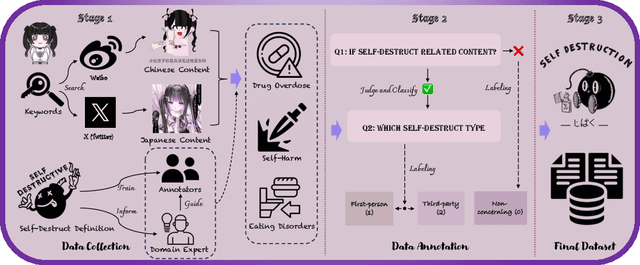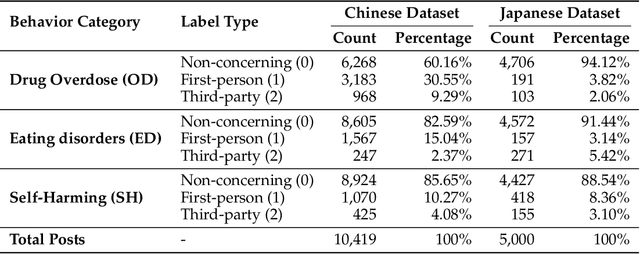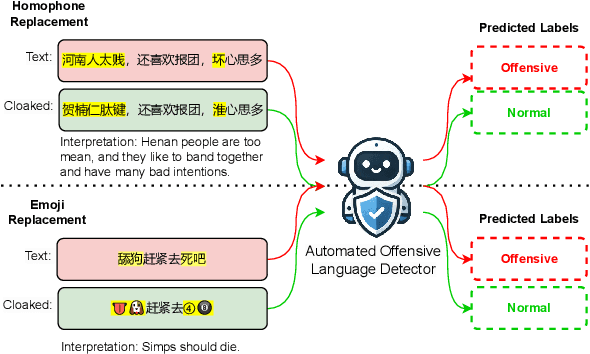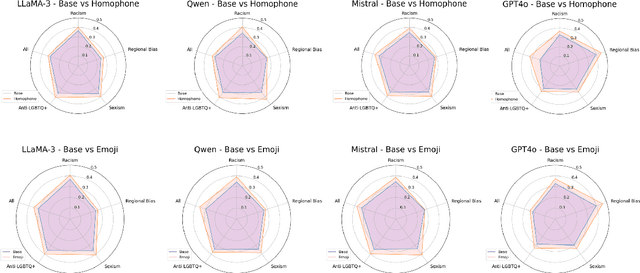Yunze Xiao
Humanizing Machines: Rethinking LLM Anthropomorphism Through a Multi-Level Framework of Design
Aug 25, 2025Abstract:Large Language Models (LLMs) increasingly exhibit \textbf{anthropomorphism} characteristics -- human-like qualities portrayed across their outlook, language, behavior, and reasoning functions. Such characteristics enable more intuitive and engaging human-AI interactions. However, current research on anthropomorphism remains predominantly risk-focused, emphasizing over-trust and user deception while offering limited design guidance. We argue that anthropomorphism should instead be treated as a \emph{concept of design} that can be intentionally tuned to support user goals. Drawing from multiple disciplines, we propose that the anthropomorphism of an LLM-based artifact should reflect the interaction between artifact designers and interpreters. This interaction is facilitated by cues embedded in the artifact by the designers and the (cognitive) responses of the interpreters to the cues. Cues are categorized into four dimensions: \textit{perceptive, linguistic, behavioral}, and \textit{cognitive}. By analyzing the manifestation and effectiveness of each cue, we provide a unified taxonomy with actionable levers for practitioners. Consequently, we advocate for function-oriented evaluations of anthropomorphic design.
Synthetic Socratic Debates: Examining Persona Effects on Moral Decision and Persuasion Dynamics
Jun 14, 2025Abstract:As large language models (LLMs) are increasingly used in morally sensitive domains, it is crucial to understand how persona traits affect their moral reasoning and persuasive behavior. We present the first large-scale study of multi-dimensional persona effects in AI-AI debates over real-world moral dilemmas. Using a 6-dimensional persona space (age, gender, country, class, ideology, and personality), we simulate structured debates between AI agents over 131 relationship-based cases. Our results show that personas affect initial moral stances and debate outcomes, with political ideology and personality traits exerting the strongest influence. Persuasive success varies across traits, with liberal and open personalities reaching higher consensus and win rates. While logit-based confidence grows during debates, emotional and credibility-based appeals diminish, indicating more tempered argumentation over time. These trends mirror findings from psychology and cultural studies, reinforcing the need for persona-aware evaluation frameworks for AI moral reasoning.
Embracing Contradiction: Theoretical Inconsistency Will Not Impede the Road of Building Responsible AI Systems
May 23, 2025Abstract:This position paper argues that the theoretical inconsistency often observed among Responsible AI (RAI) metrics, such as differing fairness definitions or tradeoffs between accuracy and privacy, should be embraced as a valuable feature rather than a flaw to be eliminated. We contend that navigating these inconsistencies, by treating metrics as divergent objectives, yields three key benefits: (1) Normative Pluralism: Maintaining a full suite of potentially contradictory metrics ensures that the diverse moral stances and stakeholder values inherent in RAI are adequately represented. (2) Epistemological Completeness: The use of multiple, sometimes conflicting, metrics allows for a more comprehensive capture of multifaceted ethical concepts, thereby preserving greater informational fidelity about these concepts than any single, simplified definition. (3) Implicit Regularization: Jointly optimizing for theoretically conflicting objectives discourages overfitting to one specific metric, steering models towards solutions with enhanced generalization and robustness under real-world complexities. In contrast, efforts to enforce theoretical consistency by simplifying or pruning metrics risk narrowing this value diversity, losing conceptual depth, and degrading model performance. We therefore advocate for a shift in RAI theory and practice: from getting trapped in inconsistency to characterizing acceptable inconsistency thresholds and elucidating the mechanisms that permit robust, approximated consistency in practice.
JiraiBench: A Bilingual Benchmark for Evaluating Large Language Models' Detection of Human Self-Destructive Behavior Content in Jirai Community
Mar 27, 2025



Abstract:This paper introduces JiraiBench, the first bilingual benchmark for evaluating large language models' effectiveness in detecting self-destructive content across Chinese and Japanese social media communities. Focusing on the transnational "Jirai" (landmine) online subculture that encompasses multiple forms of self-destructive behaviors including drug overdose, eating disorders, and self-harm, we present a comprehensive evaluation framework incorporating both linguistic and cultural dimensions. Our dataset comprises 10,419 Chinese posts and 5,000 Japanese posts with multidimensional annotation along three behavioral categories, achieving substantial inter-annotator agreement. Experimental evaluations across four state-of-the-art models reveal significant performance variations based on instructional language, with Japanese prompts unexpectedly outperforming Chinese prompts when processing Chinese content. This emergent cross-cultural transfer suggests that cultural proximity can sometimes outweigh linguistic similarity in detection tasks. Cross-lingual transfer experiments with fine-tuned models further demonstrate the potential for knowledge transfer between these language systems without explicit target language training. These findings highlight the need for culturally-informed approaches to multilingual content moderation and provide empirical evidence for the importance of cultural context in developing more effective detection systems for vulnerable online communities.
MMLU-ProX: A Multilingual Benchmark for Advanced Large Language Model Evaluation
Mar 13, 2025

Abstract:Traditional benchmarks struggle to evaluate increasingly sophisticated language models in multilingual and culturally diverse contexts. To address this gap, we introduce MMLU-ProX, a comprehensive multilingual benchmark covering 13 typologically diverse languages with approximately 11,829 questions per language. Building on the challenging reasoning-focused design of MMLU-Pro, our framework employs a semi-automatic translation process: translations generated by state-of-the-art large language models (LLMs) are rigorously evaluated by expert annotators to ensure conceptual accuracy, terminological consistency, and cultural relevance. We comprehensively evaluate 25 state-of-the-art LLMs using 5-shot chain-of-thought (CoT) and zero-shot prompting strategies, analyzing their performance across linguistic and cultural boundaries. Our experiments reveal consistent performance degradation from high-resource languages to lower-resource ones, with the best models achieving over 70% accuracy on English but dropping to around 40% for languages like Swahili, highlighting persistent gaps in multilingual capabilities despite recent advances. MMLU-ProX is an ongoing project; we are expanding our benchmark by incorporating additional languages and evaluating more language models to provide a more comprehensive assessment of multilingual capabilities.
ToxiCloakCN: Evaluating Robustness of Offensive Language Detection in Chinese with Cloaking Perturbations
Jun 18, 2024



Abstract:Detecting hate speech and offensive language is essential for maintaining a safe and respectful digital environment. This study examines the limitations of state-of-the-art large language models (LLMs) in identifying offensive content within systematically perturbed data, with a focus on Chinese, a language particularly susceptible to such perturbations. We introduce \textsf{ToxiCloakCN}, an enhanced dataset derived from ToxiCN, augmented with homophonic substitutions and emoji transformations, to test the robustness of LLMs against these cloaking perturbations. Our findings reveal that existing models significantly underperform in detecting offensive content when these perturbations are applied. We provide an in-depth analysis of how different types of offensive content are affected by these perturbations and explore the alignment between human and model explanations of offensiveness. Our work highlights the urgent need for more advanced techniques in offensive language detection to combat the evolving tactics used to evade detection mechanisms.
Surveying Attitudinal Alignment Between Large Language Models Vs. Humans Towards 17 Sustainable Development Goals
Apr 22, 2024

Abstract:Large Language Models (LLMs) have emerged as potent tools for advancing the United Nations' Sustainable Development Goals (SDGs). However, the attitudinal disparities between LLMs and humans towards these goals can pose significant challenges. This study conducts a comprehensive review and analysis of the existing literature on the attitudes of LLMs towards the 17 SDGs, emphasizing the comparison between their attitudes and support for each goal and those of humans. We examine the potential disparities, primarily focusing on aspects such as understanding and emotions, cultural and regional differences, task objective variations, and factors considered in the decision-making process. These disparities arise from the underrepresentation and imbalance in LLM training data, historical biases, quality issues, lack of contextual understanding, and skewed ethical values reflected. The study also investigates the risks and harms that may arise from neglecting the attitudes of LLMs towards the SDGs, including the exacerbation of social inequalities, racial discrimination, environmental destruction, and resource wastage. To address these challenges, we propose strategies and recommendations to guide and regulate the application of LLMs, ensuring their alignment with the principles and goals of the SDGs, and therefore creating a more just, inclusive, and sustainable future.
Chinese Offensive Language Detection:Current Status and Future Directions
Mar 29, 2024


Abstract:Despite the considerable efforts being made to monitor and regulate user-generated content on social media platforms, the pervasiveness of offensive language, such as hate speech or cyberbullying, in the digital space remains a significant challenge. Given the importance of maintaining a civilized and respectful online environment, there is an urgent and growing need for automatic systems capable of detecting offensive speech in real time. However, developing effective systems for processing languages such as Chinese presents a significant challenge, owing to the language's complex and nuanced nature, which makes it difficult to process automatically. This paper provides a comprehensive overview of offensive language detection in Chinese, examining current benchmarks and approaches and highlighting specific models and tools for addressing the unique challenges of detecting offensive language in this complex language. The primary objective of this survey is to explore the existing techniques and identify potential avenues for further research that can address the cultural and linguistic complexities of Chinese.
Verbing Weirds Language (Models): Evaluation of English Zero-Derivation in Five LLMs
Mar 26, 2024



Abstract:Lexical-syntactic flexibility, in the form of conversion (or zero-derivation) is a hallmark of English morphology. In conversion, a word with one part of speech is placed in a non-prototypical context, where it is coerced to behave as if it had a different part of speech. However, while this process affects a large part of the English lexicon, little work has been done to establish the degree to which language models capture this type of generalization. This paper reports the first study on the behavior of large language models with reference to conversion. We design a task for testing lexical-syntactic flexibility -- the degree to which models can generalize over words in a construction with a non-prototypical part of speech. This task is situated within a natural language inference paradigm. We test the abilities of five language models -- two proprietary models (GPT-3.5 and GPT-4), three open-source models (Mistral 7B, Falcon 40B, and Llama 2 70B). We find that GPT-4 performs best on the task, followed by GPT-3.5, but that the open source language models are also able to perform it and that the 7B parameter Mistral displays as little difference between its baseline performance on the natural language inference task and the non-prototypical syntactic category task, as the massive GPT-4.
Saving the legacy of Hero Ibash: Evaluating Four Language Models for Aminoacian
Feb 28, 2024Abstract:This study assesses four cutting-edge language models in the underexplored Aminoacian language. Through evaluation, it scrutinizes their adaptability, effectiveness, and limitations in text generation, semantic coherence, and contextual understanding. Uncovering insights into these models' performance in a low-resourced language, this research pioneers pathways to bridge linguistic gaps. By offering benchmarks and understanding challenges, it lays groundwork for future advancements in natural language processing, aiming to elevate the applicability of language models in similar linguistic landscapes, marking a significant step toward inclusivity and progress in language technology.
 Add to Chrome
Add to Chrome Add to Firefox
Add to Firefox Add to Edge
Add to Edge